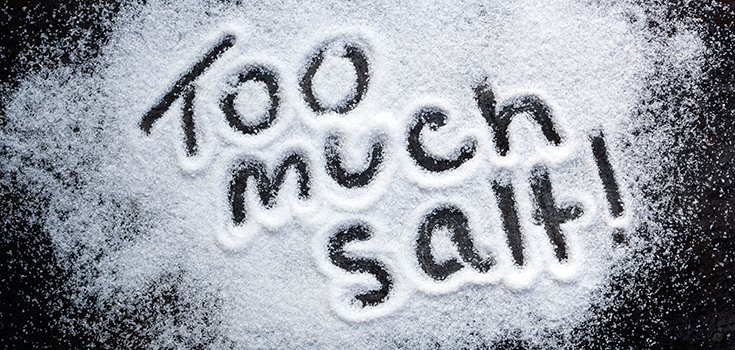FDA Hopes Restaurants, Companies Will Agree to Reduce Salt in Food

While some areas, such as New York City, are working to make sure that individuals have the full picture of what they’re putting in their mouths (by placing salt warning icons next to food menu items), efforts are being made on a national level to actually lower sodium content in food.
The FDA announced that it wants to take things a step further, by urging restaurants and companies to lower the amount of salt they put in their foods. The organizations would like to see sodium levels reduced by 1/3 over the next decade, in the hopes of preventing thousands of cases of high blood pressure every year.
Nine out of 10 Americans consume an average of 3,400 milligrams of sodium a day – 50% more than the recommended daily limit. One 1 3 Americans also have high blood pressure, and only half of them have the condition under control. But most people don’t get their sodium from the salt shaker on their kitchen table; the majority is added to food by manufacturers.
Take a turkey sandwich, for example. There’s a lot of salt in the meat, no doubt, but many people don’t realize there’s a lot of salt in the bread, too. As you can see from the graphic below, just 1 slice of bread can contain 200 mg of sodium.
Read: What – You Still Think Salt Consumption Causes High Blood Pressure?
Susan Mayne, director of the FDA’s Center for Food Safety and Applied Nutrition, said in a statement to NPR:
“Experts at the Institute of Medicine have concluded that reducing sodium intake to 2,300 mg per day can significantly help Americans reduce their blood pressure and ultimately prevent hundreds of thousands of premature illnesses and deaths.”

Thomas Frieden, director of the CDC, writes that reducing Americans’ sodium intake by just 12% could prevent 32,000 heart attacks and 20,000 strokes a year. [1]
Sylvia Burwell, Secretary of the Department of Health and Human Development, told USA Today:
“Many Americans want to reduce sodium in their diets, but that’s hard to do when much of it is in everyday products we buy in stores and restaurants. Today’s announcement is about putting power back in the hands of consumers, so that they can better control how much salt is in the food they eat and improve their health.”
Reducing Salt Levels is Voluntary
The FDA has been considering limits on salts in processed foods since 2007. The proposed guidelines are voluntary, meaning food companies will not be forced to make any changes. Mayne expressed that the agency hopes to engage the industry in how best to implement changes.
Health and Human Services Secretary Sylvia Burwell said in a statement announcing the draft targets:
“Many Americans want to reduce sodium in their diets, but that’s hard to do when much of it is in everyday products we buy in stores and restaurants.”
Some companies have already expressed support for the proposed guidelines, including Nestle, which makes DiGiorno pizza and Lean Cuisine frozen meals.
Nestle CEO Paul Bulcke told NPR in a recent interview:
“What we commit to is to … invest further — through our research and development — to reduce [sodium].”
He noted that Nestle had reduced the salt in its DiGiorno brand pizzas by an average 11%. The revamped pizzas, he said, were able to maintain the crust “flavor, texture, and shelf life that had made them popular.”
The FDA’s draft targets have the full support of the American Heart Association, as well as the American Academy of Pediatrics, which issued a statement that reads:
“Although voluntary not mandatory, the Academy welcomes this practical step to improve the quality of Americans’ diets and ultimately, the health of children and urges industry to work to achieve the proposed reductions in the draft guidance without delay.”
In the U.S., children consume just as much sodium as adults.
Read: 10 Reasons To Ignore Mainstream Media’s “Conventional Wisdom” on Salt
But there is some evidence to suggest the link between high sodium and levels and heart disease is murkier than the FDA will admit. People who have hypertension can reduce their blood pressure by reducing sodium and eating more fiber; however, lowering sodium intake might not benefit people with normal blood pressure.
The results of a study published in JAMA in 2011 in which doctors followed nearly 3,700 healthy people about 8 years suggested that lower sodium levels may actually contribute to heart disease. [2]
Sources:
[2] USA Today

Everything in moderation. Salt plays a pivotal role and has many uses like curing and preserving meat.
The Importance of Salt in Your Diet
If you are under the impression that salt is just another way to decrease your health and add to your waistline, then you should know there are benefits to adding a little salt to your diet. Salt plays a role in water retention, muscle contraction, and contains nutrients that are vital to your stomach. Salt in moderation is actually very important to your diet.
About a year ago, I drove myself gingerly to the emerg. room. After blood tests, they found why I was so dizzy. My sodium level, which is normal between 135–140 had dropped to 115. Was in ICU on drip of sodium for three days. I usually now take a teaspoon of sea salt once or twice a week. Have not had another episode. Nanny state does not know what is best.
NO study has ever made the connection between salt intake and hypertension. It is an unproven theory, just like cholesterol and heart disease.